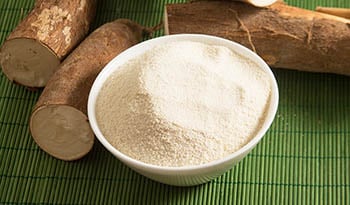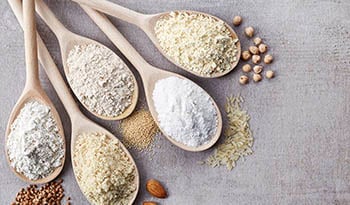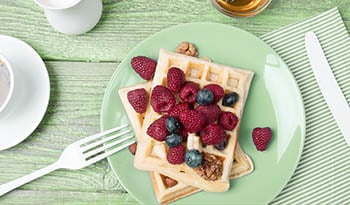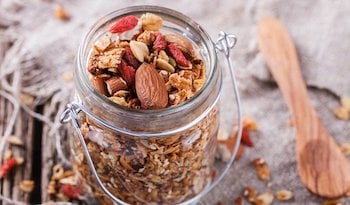Zásobte svou kuchyň 10 nejlepších bezlepkových nezbytností dietologa

Možná jste začali bezlepkovou změnu životního stylu a hledáte další způsoby, jak zůstat na správné cestě s vaší novou dietou. Nebo jste možná roky dodržovali bezlepkovou dietu, ale hledáte nové nápady. Tato příručka přezkoumá základy bezlepkové stravy, které usnadňují pokračování nebo začátek bezlepkového života. Začněme základy!
Co je lepek?
Lepek je cokoli, co obsahuje zrna pšenice, ječmene nebo žita. Kromě toho oves obsahuje lepek ze zpracování, ale lze jej zakoupit certifikovaný bez lepku u některých společností. Aby byl produkt ve Spojených státech označen jako bezlepkový, musí obsahovat méně než 20 ppm (dílů na milion) lepku. Toto je množství, o kterém se říká, že nezhoršuje osoby s celiakií. V jiných zemích je potřeba méně než 5 ppm lepku, aby bylo označeno jako bezlepkové.
Bezlepková certifikace
Tady to začíná být složité. Za prvé, bezlepkové označování je volitelné. Kromě toho je testování jakéhokoli lepku v produktu také volitelné. Pokud tedy máte celiakii nebo alergii nebo stav, který je velmi narušen kontaminací lepkem, měli byste hledat certifikované bezlepkové produkty. Tato certifikace znamená, že výrobek pravidelně testují. Existují různé odznaky a štítky, které mohou vykazovat certifikaci na produktu. Klíčem je však hledat slovo „certifikováno“.
Základy bezlepkové stravy
1. Doplňky označené jako bezlepkové
Bezlepkové označování doplňků je také volitelné pro výrobce. Když tedy hledáte bezlepkové doplňky, musíte si přečíst popis a štítek přísady, abyste zjistili, zda je uvedeno, že je bezlepkový. Bez pšenice neznamená bezlepkové, proto je důležité hledat pojmy „bezlepkové“.
Lepek lze nalézt v škrobových plnidlech v doplňcích, jako je dextróza nebo jiné škroby. Častěji se však tyto škroby vyrábějí z kukuřice nebo rýže. Příležitostně doplňky odhalí, že škrob je na bázi rýže, nebo jasně uvedou, že produkt je bezlepkový.
Dalším běžným zdrojem lepku je pšenice obsahující lepek, ječmenná tráva nebo oves. Pšeničná tráva je přirozeně bezlepková, ale často se během výroby vplíží lepek z celé rostliny. Proto musí pšeničná tráva nebo výrobky obsahující ovesné vločky uvádět, že jsou bezlepkové.
2. Bezlepkový certifikovaný oves
Jak již bylo zmíněno, možná budete chtít hledat oves, který je certifikován bez lepku, když dodržujete bezlepkovou dietu. Oves a ovesné vločky jsou přirozeně bezlepkové, ale při výrobě jsou často kontaminovány pšenicí, ječmenem nebo žitem.
Certifikovaný bezlepkový oves se začíná objevovat ve většině obchodů s potravinami, nicméně toto je položka, kterou možná budete muset zakoupit online nebo v obchodech se zdravou výživou, v závislosti na vaší místní dostupnosti.
3. Quinoa
Quinoa je vlastně pseudozrno, což znamená, že je to technicky semeno! Proto je quinoa přirozeně bezlepková a také kompletní bílkovina. Díky tomu je quinoa skvělým základem spíže, který lze zahrnout do jakéhokoli jídla po celý týden. Můžete dokonce nahradit horkou vařenou quinoa teplou snídaní místo smetany z pšenice nebo tradičních obilovin. Stačí vařit podle pokynů na obalu a poté doplnit svým oblíbeným ovocem, ořechy a kořením!
4. Bezlepková mouka na pečení
Toto je nutnost, pokud máte rádi pečení z domova. Tyto bezlepkové moučné směsi jsou často směsí tapioky, rýže a/nebo bramborových škrobů. Nabízejí pohodlí, že mohou nahradit směs bezlepkové mouky rovnoměrně moukou na bázi pšenice. Můžete si vyrobit sušenky, muffiny, palačinky a další. Další možností je nahradit pšeničnou mouku mandlovou moukou nebo kokosovou moukou nebo moukou moukou. Směsi mouky bez lepku se začínají objevovat v místních obchodech s potravinami, ale mohou nést pouze jednu značku. Pokud hledáte konkrétní směs bezlepkových ingrediencí, možná budete chtít nakupovat online.
5. Bezlepkové zábaly
Bezlepkové zábaly jsou příjemnou volbou pro přípravu rychlých obědů. Existuje mnoho nových možností bezlepkových zábalů, jako jsou kokosové zábaly. Některé z těchto obalů mohou být označeny jako „paleo“, což znamená, že byly vyrobeny bez zrn. Místo zrn často používají směs semen, kokosu a/nebo tapioky.
To poskytuje trochu více tuku a bílkovin, aby jídlo zůstalo vyvážené a výživné. Můžete najít mnoho bezobilných zábalů nebo sušenek, které dodají obědu pěknou rozmanitost a pomáhají udržovat bezlepkový životní styl méně omezující. Rádi nakupujeme naše kokosové zábaly online, protože obecně existuje větší rozmanitost chutí a dostupnosti. Pak jednoduše naplňte tradičními obědovými náplněmi, jako je libové maso nebo luštěniny, zelenina a koření dle výběru!
6. Bezlepkové těstoviny
Toto je jedna z mých oblíbených možností stravování ve všední noci a nezbytnou součástí spíže. Čočkové, cizrnové nebo fazolové těstoviny jsou přirozeně bezlepkové a mají vysoký obsah bílkovin, což pomáhá udržovat jídla v týdnu jednoduchá. Další možností, která nabízí nejjemnější chuť pro nejnáročnější jedlíky, jsou těstoviny z hnědé rýže, které mají příjemnou chuť podobnou chuti tradičních pšeničných těstovin a nabízejí celozrnnou variantu. Můžete najít další bezlepkové těstoviny , které jsou směsí kukuřice, quinoa a/nebo rýže. Ty lze snáze najít v místních obchodech s potravinami. Pokud však chcete konkrétní tvar nebo přísadu, je lepší nakupovat online.
7. Bezlepková směs na pizzu
Možná nemáte místní restauraci, která vyrábí bezlepkovou pizzu, a musíte to udělat sami. Nebo byste možná chtěli vařit více z domova. Když chcete pizzu, když chcete pizzu, máte po ruce směs kůrky na pizzu, je bezstresová volba. Jedná se o suché směsi, do kterých jednoduše přidáte vodu a vytvoříte těsto. Tento proces je mnohem jednodušší než tradiční těsto na pizzu: jednoduše promíchejte a pečte! Pak přidejte své oblíbené polevy a jste připraveni na pizzu.
8. Kokosové aminokyseliny
Sójová omáčka tradičně obsahuje pšenici ve zpracování. Můžete si také zakoupit bezlepkovou etiketovanou sójovou omáčku. Jedná se jednoduše o sójovou omáčku, která byla vyrobena bez pšenice a je bezpečná pro bezlepkový životní styl. Kokosové aminos jsou další alternativou sójové omáčky. Kokosové aminos chutnají velmi podobně jako sójová omáčka a jsou vyrobeny z mízy kokosového stromu. Najdete zde také kokosové amino teriyaki omáčky, které mají tradičně jako přísadu pšenici ze sójové omáčky. To umožňuje snadná noční jídla ve všední den a ochucení hranolků.
9. Šíp nebo kukuřičný škrob
Jedná se o bezlepkové škrobové prášky , které se používají k zahušťování potravin. Šípkový prášek je škrob z několika tropických kořenových rostlin. Buď z nich je skvělé mít ve spíži, aby zahušťovala polévku nebo omáčku. Někdy se také používají při pečení. Tradičně se pšeničná mouka používá k výrobě omáčky nebo zahuštění polévky. Ale můžete snadno nahradit bezlepkový škrob! Ty jsou obzvláště užitečné mít kolem sebe během prázdnin, kdy můžete vařit více omáček a omáček.
10. Bezlepková osobní péče
V neposlední řadě možná budete chtít věnovat pozornost výrobkům osobní péče, pokud jste citliví na lepek. Zejména se podívejte na bezlepkové výrobky osobní péče a kosmetiku, kterou si nanášíte na obličej, jako jsou rtěnky a pleťové krémy. Lotion je nejběžnějším produktem osobní péče, který obsahuje konkrétně pšenici. To je obtížnější zjistit na etiketě, protože na produktu nemusí být bezlepkový popis. Je lepší přečíst si seznam složek a hledat pšenici jako složku.
Rychlé občerstvení
Bezlepkový životní styl nemusí být obtížný. Výzvou je, že bezlepkové položky nemusí být ve vašem městě snadno dostupné. Nebo jste si možná nebyli jisti, co jiného zahrnout do své stravy. Naštěstí se za posledních pět let bezlepkové produkty staly dostupnějšími v obchodech a online. Jakmile vybavíte svou kuchyň některými z těchto základních věcí, bude bezlepkové stravování méně stresující a pohodlnější.
Odkazy:
- Biesiekierski JR. Co je lepek? Časopis gastroenterologie a hepatologie. 2017; 32 (S1): 78-81. doi: 10.1111/jgh.13703
- Domov. Skupina pro nesnášenlivost lepku v Severní Americe - GFCO. Přístup k 29. červnu 2021. https://gfco.org
VYLOUČENÍ ODPOVĚDNOSTI: Tento blog není určen ke stanovení diagnózy...














































































 Obsah
Obsah








